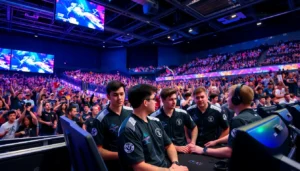Table of Contents
ToggleWhen it comes to gaming, turn-based combat often gets a bad rap. Critics argue it’s slow and tedious, but let’s be real—what’s more exhilarating than planning your next move while your opponent sweats bullets? It’s like a chess match on steroids, where every decision could mean glorious victory or epic defeat.
In a world where reflexes reign supreme, turn-based combat stands out as a strategic haven. It invites players to think critically and act deliberately, transforming battles into a mental showdown. So grab your controller, take a deep breath, and prepare to unleash your inner tactician. It’s time to dive into the art of turn-based combat and discover why it’s not just a game; it’s a thrilling test of wits that keeps players coming back for more.
Overview of Turn-Based Combat
Turn-based combat represents a strategic approach to gameplay in which players take turns to make moves. This format allows individuals to assess their options carefully before executing actions. Players must think critically about their strategies, considering the strengths and weaknesses of their characters against opponents.
Many popular games adopt this combat style, such as “Final Fantasy,” “XCOM,” and “Fire Emblem.” Each title showcases different mechanics, promoting player engagement through tactical decision-making. With options to heal, attack, or defend, players can create unique strategies that suit their playstyles.
Engagement in turn-based combat often leads to intense battles, where planning becomes paramount. Characters may possess varying abilities, allowing for diverse team compositions that enhance strategy. The interplay between offense and defense fosters a dynamic experience, making each turn significant.
An essential aspect of turn-based combat is the pacing it provides. The deliberate nature allows players to anticipate their adversaries’ moves while planning their own. This reflective time invites deeper analytical thought, ultimately elevating the overall strategy.
Despite some critiques regarding speed, many players find excitement in this format. The tension builds as they weigh their options carefully, creating moments of exhilaration typical of high-stakes encounters. By emphasizing intellect over reflexes, turn-based combat nurtures a different level of engagement in gaming.
Ultimately, this format caters to those who appreciate strategic depth, inviting them to immerse themselves in calculated decision-making. Engaging with turn-based combat transforms routine encounters into intellectual duels, highlighting why it resonates with so many players.
Key Features of Turn-Based Combat

Turn-based combat features several key elements that enhance gameplay and strategy. Players engage in strategic decision-making and resource management to maximize their chances of victory.
Strategic Decision Making
Strategic decision-making thrives in turn-based combat. Players must evaluate their options each turn, weighing risks against potential rewards. Decisions can include selecting attacks or defenses, positioning characters on the battlefield, or utilizing abilities. Many games prompt players to anticipate their opponent’s moves while deploying their tactics. This level of foresight offers an intellectual challenge, transforming each battle into a chess match where planning leads to victory. Decisions carry weight, as each choice significantly impacts the outcome of encounters.
Resource Management
Resource management plays a critical role in turn-based combat. Players often manage health, energy, or item usage during battles. Maximizing the efficiency of resources determines the feasibility of ongoing strategies. Players face choices on how to spend limited resources, which could involve healing teammates or launching powerful attacks. Games frequently introduce mechanics that require players to consider long-term resource usage across multiple encounters. Success relies not just on short-term gains but on sustainable strategies that prolong survival during challenging campaigns.
Popular Games Featuring Turn-Based Combat
Turn-based combat remains popular across various gaming titles. Numerous games showcase the mechanics and strategic depth inherent in this gameplay style.
Classic Titles
“Final Fantasy” stands out as a defining classic, renowned for its rich narrative and intricate turn-based systems. Players engage in combat where character abilities and elemental weaknesses require careful consideration. “Chrono Trigger” also earns praise, featuring time travel and character synergy that enriches the tactical experience. “Fire Emblem” adds another layer with its focus on permadeath and unit positioning, compelling players to develop deep strategies for their rosters.
Modern Innovations
“XCOM: Enemy Unknown” exemplifies a modern take on turn-based strategy. The game emphasizes squad management and tactical positioning on a grid-based map, pushing players to make impactful decisions. “Divinity: Original Sin 2” integrates RPG elements with turn-based mechanics, offering players the freedom to craft unique builds and spell interactions. “Gears Tactics” redefines the genre further by combining real-time action with turn-based engagement, catering to a more diverse audience while maintaining strategic depth.
Advantages of Turn-Based Combat
Turn-based combat offers several advantages that enhance the overall gaming experience. The strategic nature encourages thoughtful decision-making and engagement.
Accessibility for New Players
New players often find turn-based combat approachable. This gameplay style allows them to take their time and process information without the pressure of real-time actions. By enabling players to consider their moves carefully, they can learn game mechanics at a comfortable pace. Moreover, tutorials and user-friendly interfaces commonly accompany these games, further easing the learning curve. Engaging in battles becomes less daunting, making it easier for newcomers to connect with the game’s strategy and narrative.
Depth of Strategy
Strategic depth defines turn-based combat, appealing to players who crave complex gameplay. Players can analyze their options, anticipate opponents’ moves, and develop multifaceted strategies. Each decision shapes the battle’s outcome, requiring critical thinking and foresight. Additionally, diverse character abilities and environmental factors come into play, offering players various approaches to combat. The layered strategies lead to satisfying victories, as players experience a mix of challenge and achievement. Engaging in these deep strategies transforms encounters into rewarding and memorable experiences.
Challenges Faced by Turn-Based Combat
Turn-based combat faces several challenges that can impact player engagement and satisfaction. Understanding these challenges helps in appreciating the intricacies of this gameplay style.
Pacing Issues
Pacing issues commonly arise in turn-based combat. Players often experience frustration with extended waiting times between turns, which can diminish excitement. Continuous engagement remains critical, but prolonged deliberation can lessen the urgency. Games may need to strike a balance between strategic depth and the flow of combat. Implementing time limits for decision-making could enhance pacing without sacrificing tactical considerations. For example, titles like “XCOM” utilize timer-based mechanics to maintain momentum, ensuring players remain connected to the action even when strategizing.
Balancing Complexity
Balancing complexity proves essential for successful turn-based combat. When mechanics become overly intricate, players might feel overwhelmed, leading to disengagement. Simplifying core systems while retaining depth requires careful consideration. Developers often prioritize accessibility without sacrificing strategic depth. For instance, games like “Fire Emblem” integrate straightforward mechanics with layered strategic challenges, making them approachable yet engaging. Striking the right balance fosters an environment where both newcomers and veterans can enjoy meaningful tactical decisions, preserving the thrill of turn-based battles.
Turn-based combat remains a captivating aspect of gaming that challenges players to think critically and strategize effectively. Its unique structure transforms battles into engaging mental contests where every decision counts. By allowing players to assess their options and manage resources, this gameplay style fosters a deeper connection to the narrative and mechanics.
As developers continue to innovate within this framework, balancing complexity with accessibility will be key. The enduring appeal of turn-based combat lies in its ability to offer diverse experiences while maintaining strategic depth. Whether through classic titles or modern adaptations, players will always find excitement in the calculated moves and tactical planning that define this genre.




